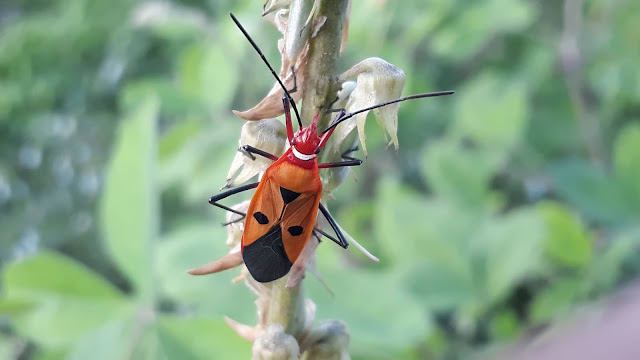Grass Demon Butterfly (Udaspes folus): Scientific Classification, Habit and Habitat, Food Habit, Identifying Characters
Grass Demon (Udaspes folus): Scientific Classification, Habit and Habitat, Food Habit, Identifying Characters
Scientific
Classification
Kingdom: Animalia
Phylum: Arthropoda
Class: Insecta
Order: Lepidoptera
Family: Hesperiidae
Genus: Udaspes
Species: folus
Habit
and Habitat:
- The grass demon is to be found in deciduous and semi-evergreen forests.
- It prefers forest edges or clearings where dappled light is present.
- This butterfly is seen chiefly during the monsoon, perhaps due to its larval host plants growing at this time of the year.
Food Habit: The adult grass demon is a Nectarivore and has a
long proboscis compared to body size. This makes it easy to get to nectar of
flowers with long corolla tubes. The grass demon caterpillar feeds on ginger,
turmeric, and their relatives Curcuma aromatica, Curcuma decipiens, Hedychium
sp. and other plants of family Sctiaminae. It has also been recorded on
Zingiber sp. and on grasses.
Identifying
Characters:
Imago: Male. Upperside
black, the basal half of both wings covered with
minute yellowish scales, markings pure
white, semi-hyaline. Forewing with a large white spot filling up the end of the
cell, two similar conjoined spots outwardly below it extending from beneath
vein 4 to the sub-median vein, hardly separated from each other by vein 2 ;
four conjugated sub-apical spots, the uppermost one minute, two similar spots
below them nearer the outer margin, a small spot between these and the two
large conjoined spots. Hindwing with a very large medial white patch with its margin in sinuous all round; abdominal area covered with yellowish hairs.
Underside is paler. Forewing with the markings as on the upper side. Hindwing with
the white medial patch extending to the abdominal margin from near the costa to
one-third above the anal angle, the extension suffused with grey, also
extending narrowly to the outer margin, double blackish-brown lunular marks,
within the white space at the bases of the sub-median nervules. Cilia blackish,
alternated with white. Antennae black; palpi, head, and body concolorous with
the wings, whitish on the underside, legs brown above, whitish beneath. Female
like the male, but the spots are larger. It is a small butterfly with a
wingspan of about 4 to 4.8 cm.
Larva: Very stout when full grown and has the habit
of resting with the first three segments after the head contracted, so as to
give the appearance of being humped about the anterior segments, the relatively
small head lying with its apex pressed on the second segment; the body is
flattened ventrally, as the larva always lies closely applied to the resting
surface; the anal segments are sloping, and the margin is closely applied to
the leaf rounded at the extremity, and somewhat thickened at the edge; when
at rest, the fourth segment is more than twice as long as the head; the head
is triangular when seen from in front, and narrowly bilobed and small for the body,
head black, with the surface rugose and shiny; each segment slightly swollen around
the spiracles; the surface of body glabrous, greasy-looking; the color of the body a watery,
very dark indigo-green, the tracheae showing through as white threads; a dark dorsal
pulsating line; end segment whitish; segments 2 and 3 yellowish, as well as the
margins of segments 4 and 5. Length 37 mm. A good deal more when fully stretched
out.
Pupa: cylindrical, very
slightly constricted dorsally only, behind the thorax, produced into a long conical
snout squarely blunt at tip; the eyes prominent; the abdomen tapering and
ends in a thin, long, more or less tapering, curved cremaster; the proboscis
reaches to the end of the cremaster, the color is a watery bright green. Length
32.75 mm.
References:




👌🏿
ReplyDelete